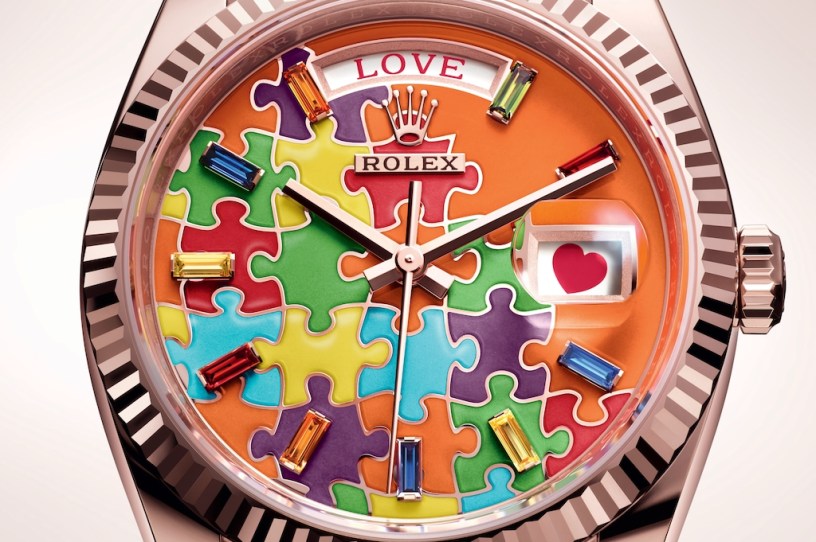Making Money, Not Watches

Every year, watch nerds—and there are dozens of us—wait with bated breath for Watches & Wonders, the big industry trade show which kicked off in Switzerland this week.
Announcements of new releases, upgrades to existing models, and discontinued lines from the major companies are obsessively seeded, bracketed, scored, and ranked in an annual horological March Madness. And the perennial tournament favorite is Rolex.
And this year, the most recognizable brand in the world seemed to have lost its mind—or at least that’s what it looked like.
Rolex, famous for its understatement and conservative design, is now featuring watch faces in candy colors and playroom patterns which, instead of the date and day, display emojis and “inspirational” words like gratitude, eternity, and peace. At first glance it seemed like reputational suicide: an Eat, Pray, Love watch for the kind of cultural Californian who shells out for crystal therapy and thousand-dollar reiki sessions.
But while the gaudy new models might horrify purists and industry snobs, they’re manna from Geneva for the YouTubers and bloggers who fuel the brand’s status. Whatever the serious watch world might think, Rolex seems poised to cash in on its own newly-minted status as an horological meme stock, pitching itself squarely at crypto bros and Instagram influencers.
The last decade and a half has seen Rolex evolve into something more than a watch company or even a luxury brand name: It now looks like Rolex has a plan to capitalize on its cultural ubiquity and make money faster than it can make watches.
Fueled by renewed interest in high-end watches over the last 20 years—including roaring demand from China and booming secondary sales of “vintage” models—Rolex is accustomed to dealing with a market hungry for its products. At its Swiss factory, Rolex can make about 1 million watches a year at maximum production capacity—but they could probably sell more than three times that number if production capacity were no issue.
More recently, high-end watches—and Rolexs in particular—have caught the attention of a new generation of collectors, cryptocurrency enthusiasts, and NFT junkies, who see them as a new way of storing wealth, just as insulated from inflation as Bitcoin and considerably more tangible than digital cartoon monkeys. And the new Rolex designs announced this week have more than a whiff of NFT aesthetics to them.
For normal people, even serious watch people, the reality is that trying to buy a brand new Rolex from one of its authorized dealers (ADs) has become practically impossible. Waiting lists for even basic models can be years long for customers who don’t have a “close relationship” with their local dealer, forged through years of big spending, to move them up the line.
The result has been a much-discussed “Rolex bubble,” with secondhand watches of all kinds, even heavily used, routinely selling for multiples of their original sticker price.
In a reflection of how the two markets track, the crypto dips and crashes of the last 18 months have seen the used Rolex market cool off a little—but only for the most overhyped and overpriced models, which are still selling for three, four, and five times their retail value.
While all of this has been good free advertising, neither Rolex nor any of its ADs were getting a penny from the roaring secondary market for their wares, at least not over the table. But that changed last year, when Rolex announced a new certified pre-owned program, in which their ADs could now officially trade in used watches, at prices far above retail, while Rolex itself would get a cut by issuing certificates of authenticity for every used watch sold via its dealer network.
Essentially, Rolex gave itself a license to print money off the trade in its own used stock, without having to make a single new watch.
The financial incentive was clear enough, even if the watch world fumed that Rolex had essentially bought into a market created by its own product shortage, almost guaranteeing prices would rise still further.
But to shore up its new investment in itself, Rolex needed to buy into its own social media hype—and that, it seems, is what this year’s releases were all about: being seen.
Apart from garish colors and patterns, Rolex jazzed up many of their staples with brighter colored dials and cases in gold and platinum sprinkled with gemstones. And a lot of models—even the most conservative offerings like the Explorer—got upsized cases, making them wear just that little bit bigger and be that little bit more visible.
Indeed, “eye-catching” seems to be Rolex’s whole ethos this year, and for good reason. It’s a simple reality of supply and demand that practically no one who wants one of these new models will be able to buy one at retail. But the few who do will plaster it all over social media, feeding the frenzy for the shiny and unattainable and funneling them to the more lucrative secondary market.
A real cynic might even wonder if the years-long wave of violent street robberies breaking over Rolex watches was a factor, too, in the decision to make everything a little more visible this year. Cities like London have been plagued by gangs, armed with guns and machetes, stalking famous Instagramers and normal pedestrians through the streets on the hunt for Rolexs. Online watch forums are full of warnings about what it’s not safe to wear and where.
In this climate, Rolex opting for bigger, brighter, bolder models across the board seems like painting a target on their retail customers. But, then again, they do say there’s no such thing as bad publicity.
What we know for sure is that Rolex has outgrown the industry it dominates. However much their new models this week may appear faddish and juvenile, they’re part of a very grown-up, calculated plan by a Swiss company that increasingly resembles a bank in its size, and whose products are now closer to currency—social and specie—than timepieces.